How to Check 240 Voltage with a Multimeter (Guide)
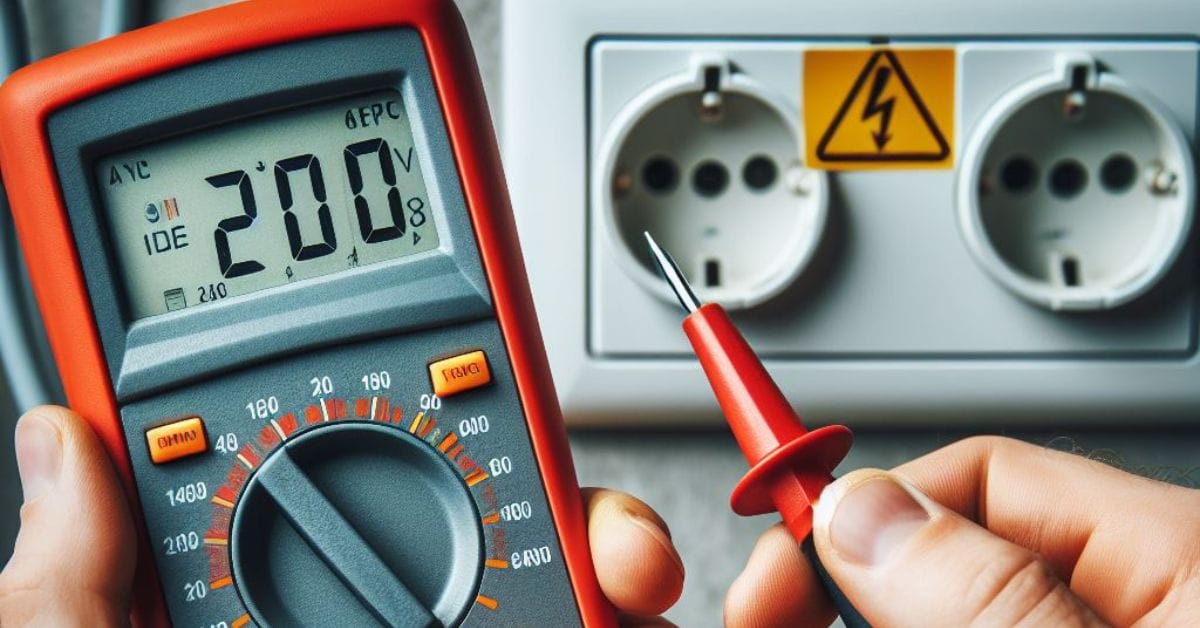
Today, I’m excited to share a crucial skill for any DIY enthusiast or homeowner – checking 240 voltage with a multimeter.
Whether you’re tackling home renovations or need to troubleshoot an appliance, knowing how to safely and accurately test for 240V power is key.
With a few simple steps and the right tools, you’ll be able to handle this task like a pro:
- Step 1: Before starting, wear insulated gloves to prevent injury from voltage contact.
- Step 2: Confirm you’re testing a real 240V component, which is essential for U.S. air conditioners and washing machines.
- Step 3: Connect the black negative probe to the COM or – port and the red positive probe to the VmA or + port.
- Step 4: Focus on AC voltage, indicated by “VAC” or “V” on your multimeter.
- Step 5: Insert the red and black leads into the outlet’s slots, ensuring contact with the metal parts for an accurate reading.
- Step 6: Compare the multimeter readings with a reference table to check if the outlet provides sufficient voltage for 240V appliances.
So, grab your multimeter, put on your safety gear, and let’s dive into this useful skill together. Let’s get started!
Understanding the Basics of 240 Voltage and Multimeters
So, what’s the deal with 240 voltage? In our homes, we usually have two types of electrical circuits. The standard ones are 120 volts, perfect for your everyday gadgets.
But then, there are the heavy hitters – the 240-volt circuits. These are the big leagues, powering up your major appliances like the dryer, oven, or air conditioning unit that keeps you cool during those scorching summer days.
Now, onto multimeters. These nifty devices are like the Swiss Army knives of electrical testing tools. I remember the first time I used one. I was working on a kitchen remodel, and we needed to check the power supply to the new oven.
With the multimeter, it was a breeze! These gadgets can measure voltage, current, and resistance, but today, we’re focusing on voltage, particularly that beefy 240 volts.
Understanding 240 volts and how to test it with a multimeter isn’t just about getting your appliances up and running. It’s about ensuring safety and efficiency in your home.
So there you have it, a quick overview of 240 voltage and multimeters from my experience. Stay safe, be smart, and be happy testing!
How to Test a 240 Volt Outlet with Multimeter
Now, I will walk you through how to check 240 voltage with a multimeter. It’s a handy skill, especially when dealing with big appliances or home renovation projects. Let’s get started.
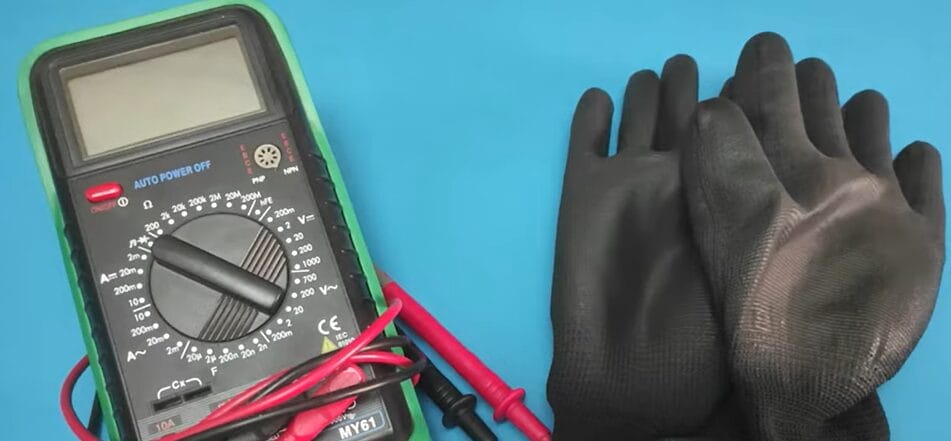
Video | Electro University
Step 1: Safety Precautions
Before you start testing 240 volts, make sure to put on those insulated gloves. This is crucial to prevent injury if you come into contact with the voltage.

Video | Electro University
Step 2: Identify Your Test Subject
Make sure you’re testing a genuine 240V electrical component. This is key for accurate diagnosis. In the U.S., the typical voltage for most devices is 120V, but larger appliances like air conditioners and washing machines require 240V.
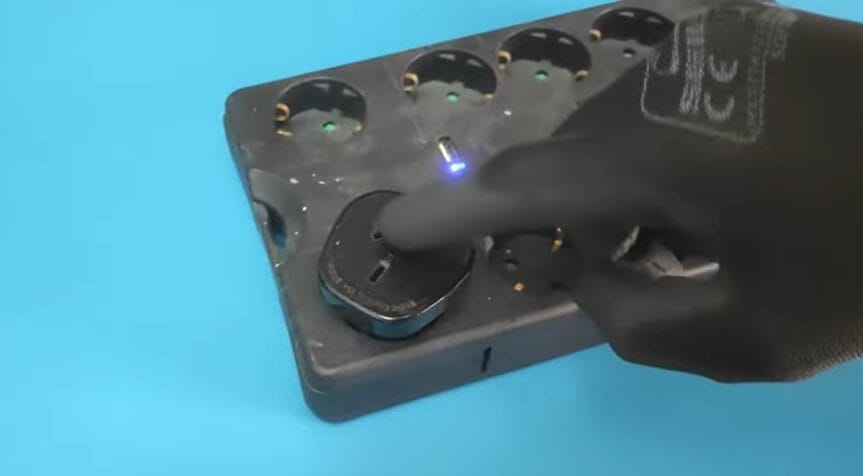
Video | Electro University
Step 3: Set Up Your Multimeter
Connect the black negative probe to the COM or – port and the red positive probe to the VmA or + port.
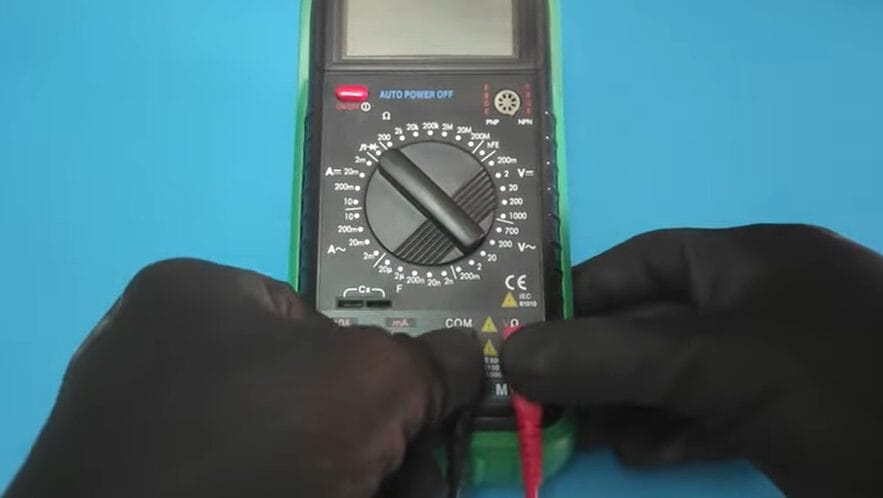
Video | Electro University
Step 4: Understanding Voltage Types
Remember, there are two types of voltage – DC and AC. We’re interested in AC voltage, the type available in your home. On the multimeter, AC voltage is indicated by “VAC” or “V”.
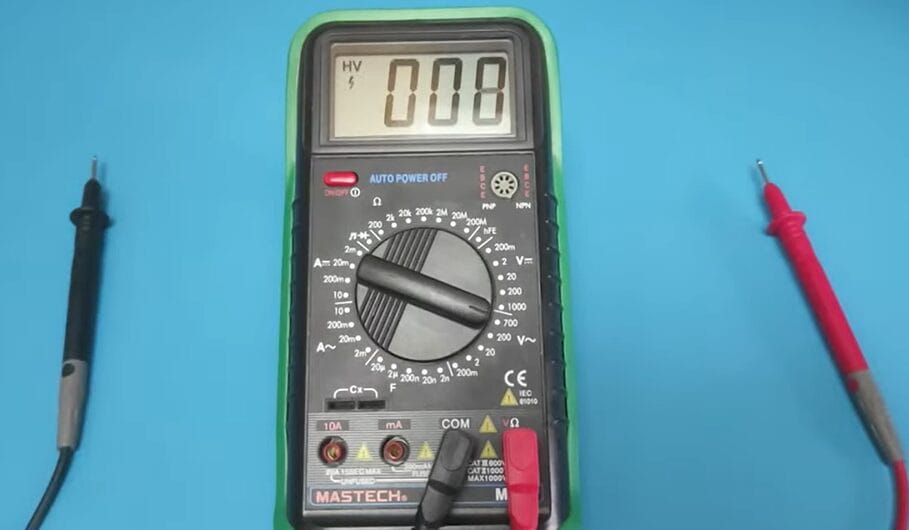
Video | Electro University
For measuring 240V, set your multimeter to the 700VAC range, as it’s the closest higher range.
Step 5: Testing the Outlet
Insert the red and black leads into the corresponding slots of the outlet.
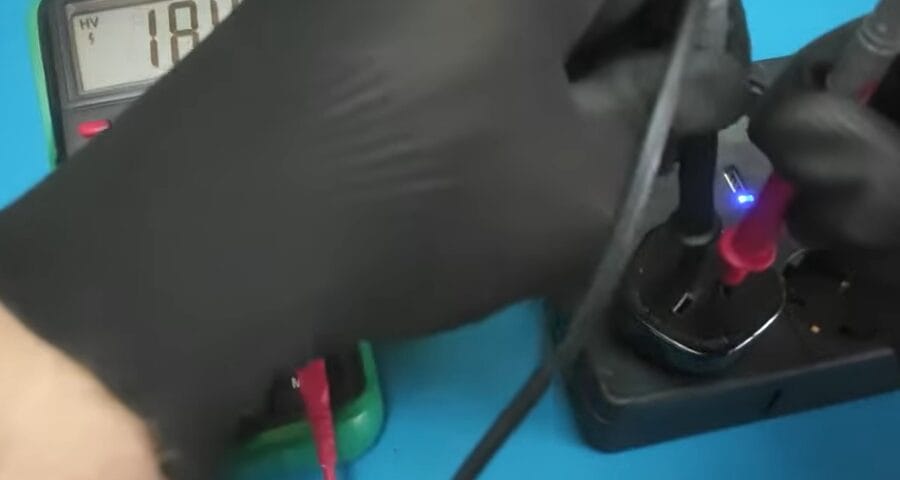
Video | Electro University
Ensure they make contact with the metal parts inside for an accurate reading.
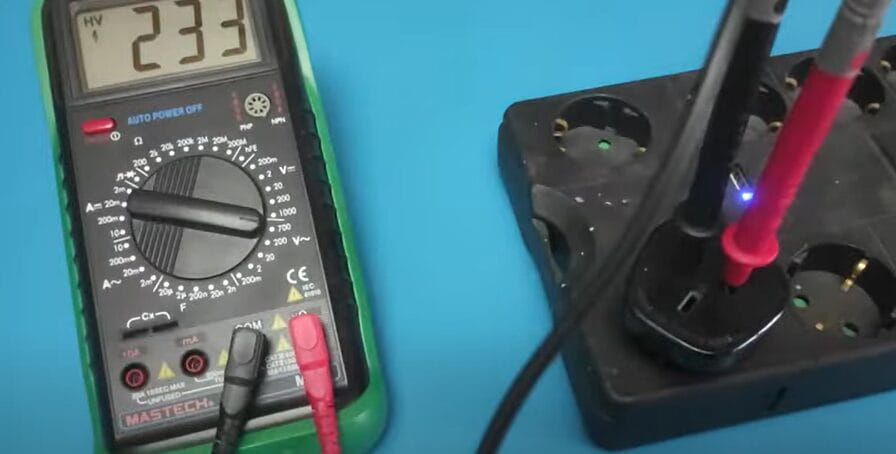
Video | Electro University
Step 6: Interpreting the Results
Finally, compare your multimeter readings with a reference table. If your value falls within a certain range, the outlet isn’t producing enough voltage for 240V appliances.
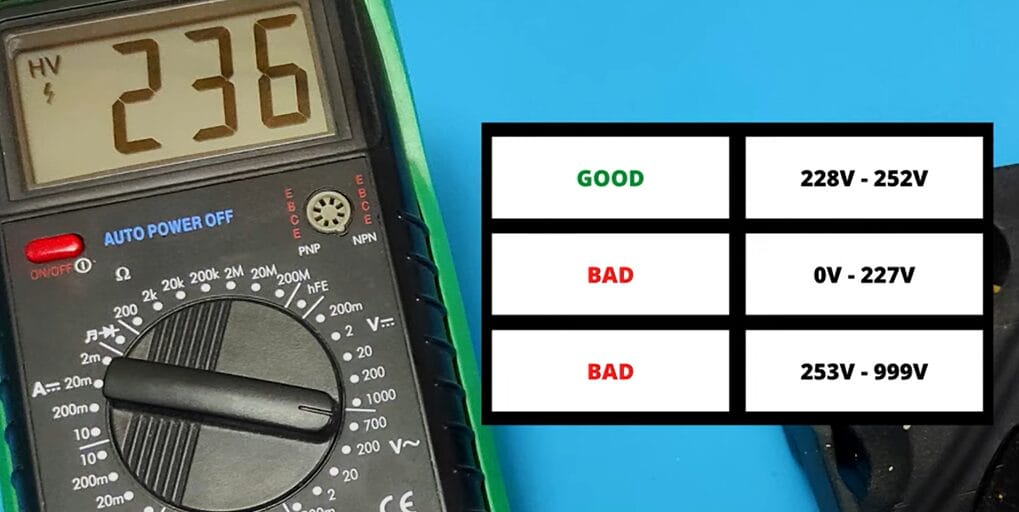
This might be the cause of electrical issues affecting your equipment.
Troubleshooting Common Problems While Checking 240 Voltage with a Multimeter
So, you’ve got your multimeter in hand, ready to check that 240-volt outlet, but things aren’t going quite as planned? Don’t sweat it! It’s common to run into a few hiccups when working with electrical systems.
Below is a straightforward table that lays out some common issues you might encounter and practical solutions to get you back on track.
| Problem | Possible Cause | Solution |
|---|---|---|
| The multimeter shows no reading | Loose connections or faulty multimeter | Double-check that the test leads are securely inserted into the multimeter and the outlet slots. If everything is connected properly, try using the multimeter on a different outlet to rule out a faulty device. |
| Reading is far below 240V | Weak or unstable power supply | This could indicate an issue with your home’s electrical system. Try testing another high-voltage outlet to see if the problem is consistent. If it is, it might be time to consult a professional electrician. |
| Erratic or fluctuating readings | Interference or a damaged outlet | Ensure there are no nearby devices causing electromagnetic interference. If the outlet looks old or damaged, it may need to be replaced. |
| The multimeter shows a constant low reading (e.g., 120V) | Incorrect test lead placement | Check if the test leads are correctly placed: the black lead should be in the neutral slot, and the red lead should be in the hot slot. Incorrect placement can lead to inaccurate readings. |
| Sparks or short circuits when testing | Incorrect handling of test leads | Always keep the metal ends of the test leads from touching each other when plugged into an outlet. This is crucial for avoiding shorts. If a short occurs, immediately disconnect the multimeter and check for any damage. |
Remember, while troubleshooting, safety should always be your top priority. If you’re unsure or uncomfortable with any part of the process, it’s always better to call a professional.
Maintaining Your Home’s Electrical System: A Simple and Effective Schedule
Let’s talk about keeping your home’s electrical system in top shape. Regular maintenance is key to ensuring everything runs safely and efficiently.
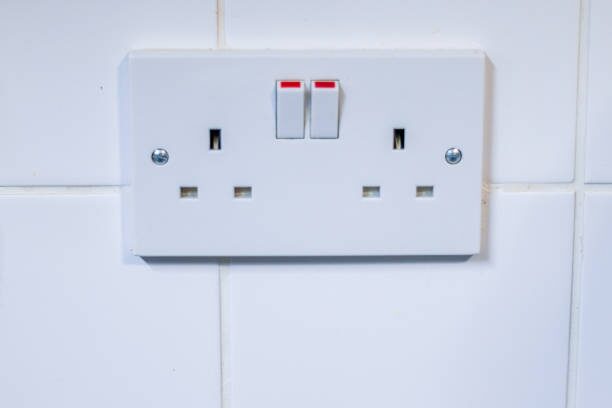
Here’s a straightforward schedule and some tips to help you stay on top.
Monthly: Visual Inspections
- Once a month, walk around your home and inspect your outlets and switches. Look for any signs of discoloration, smoke, or unusual wear. If anything looks off, it’s time to call in a professional.
Every Three Months: Test Your GFCIs
- Ground Fault Circuit Interrupters (GFCIs) are a must in areas with moisture like kitchens and bathrooms. Every three months, press the test button on these outlets. If they don’t pop out, you’ve got a safety issue on your hands.
Bi-Annually: Check Appliance Cords and Extension Cords
- Check the cords on your appliances and any extensions you use twice a year. Frayed or damaged cords aren’t just inefficient; they’re a fire hazard.
Annually: Professional Inspection
- Once a year, it’s a good idea to have a licensed electrician thoroughly inspect your home’s electrical system. They can spot issues you might miss and help prevent major problems.
As Needed: Test Outlets with a Multimeter
- If you’re ever in doubt about an outlet’s performance, test it out with a multimeter. This is especially important for frequently used outlets or power high-voltage appliances.
Remember, maintaining your home’s electrical system isn’t just about preventing issues; it’s about peace of mind. Stay safe, and keep your home running smoothly!
Frequently Asked Questions
- Can I Test 240V Outlets with Any Multimeter?
- Most multimeters can test 240V, but always check your multimeter’s specifications to ensure it can handle the voltage you plan to test.
- Can I Damage My Multimeter by Testing a 240V Outlet?
- Not, as long as your multimeter is rated for 240V or higher and you’re using it correctly. Always start with the right settings and handle the device carefully.
- Can I Use a Multimeter to Test Other Types of Outlets?
- Definitely! Multimeters are versatile tools that can test various types of outlets, including standard 120V outlets. Just adjust your settings accordingly.
- How Often Should I Test My 240V Outlets?
- Regular testing isn’t typically necessary unless you suspect an issue. However, an annual checkup by a professional electrician is a good practice for overall electrical safety.
- How Can I Tell If My Multimeter Is Working Properly Before Testing?
- A quick way to check is to test a known working outlet, preferably a standard 120V one. If your multimeter shows a reading close to 120V, it’s a good sign that it’s working correctly.
References
Organization:
- National Electrical Manufacturers Association (NEMA). https://www.nema.org/
- U.S. Department of Energy (DOE). https://www.energy.gov/
- Electrical Safety Foundation International (ESFI). https://www.esfi.org/
- National Fire Protection Association (NFPA). https://www.nfpa.org/en
Books:
- “Practical Electronics for Inventors” by Paul Scherz and Simon Monk. https://shop.harvard.com/book/9781259587542
- “Electrical Wiring Residential” by Ray C. Mullin and Phil Simmons. https://www.barnesandnoble.com/w/electrical-wiring-residential-ray-c-mullin/1116778103
Website Resources:
- Fluke Corporation. http://fluke.com/
- Electronics Hub. http://electronicshub.org/
- The Spruce. http://thespruce.com/
Video Resources:
Electro University
